ASUS Striker II Extreme: Mucho Bang, Mucho Bucks
by Kris Boughton on April 11, 2008 7:00 AM EST- Posted in
- Motherboards
ASUS Striker II Extreme Board Layout and Features

ASUS' third-generation advanced power delivery system is back and as good as ever. ASUS uses the finest ultra-low ESR, polymer capacitors from Fairchild and solid, low-DCR Yageo inductors. Simply noting the inductor count will tell you this board uses an 8-phase PWM, with one small twist though: the PWM buck controller really only supports true 4-phase operation but with an output multiplexer used to double the phase count. This means a sudden power demand placed on the system will only draw current from four of the phases while the other four sit idle, unattached from the load. From this perspective the native 6-phase design used on NVIDIA's reference boards, available from EVGA or XFX, might actually be the better solution.
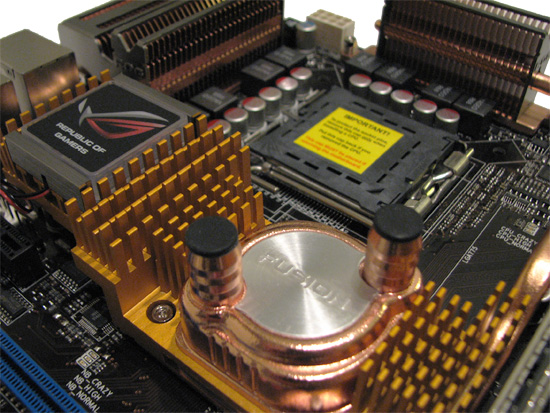
The portion of the heatsink covering the 790i SPP is extruded aluminum with a coating applied to give the illusion of copper. The integrated "Fusion" water-cooling bowl is covered with a thick copper finish inside and out ensuring there will be no issues with galvanic corrosion due to dissimilar metals. The barbs are only 3/8" inner diameter (ID) but a couple of plastic 3/8"-to-1/2" ID straight-through adapters and two 3/8" ID segments of tubing about one-half inch in length are included for those with 1/2" ID water-cooling loops. We found that removing, cleaning, and replacing the factory thermal interface material (TIM) with a small blob of OCZ Freeze was sufficient when it came to cooling the 790i SPP. The included back plates provided all the mounting pressure needed to securely fasten the stock heatsink back in place once we were done with the TIM swap-out.
The backlight for the small Republic of Gamer (R.O.G.) logo attached to the top-half of the heatsink can be turned on or off in the BIOS. Call us crazy but we think building up the fins here, providing more surface area for better heat dissipation seems like a more appropriate use of this precious space. Even a small fan would have been a better choice as far as we are concerned - aesthetics only go so far; every board should be as functional as possible.
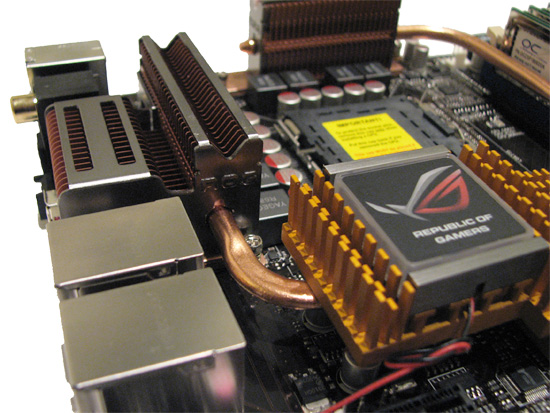
The coolers located above each bank of MOSFETs are made of high-quality copper, with an extra segment extending into the area immediately adjacent to the I/O panel. Everything is thermally joined to the SPP heatsink using a closed-loop copper heatpipe and a bit of brazing material. We were pleased to see that ASUS decided to start including back plates for the MOSFET coolers as well. These help to evenly distribute the pressures developed during mounting along the length of the cooler, making certain it sits flush atop the components below.
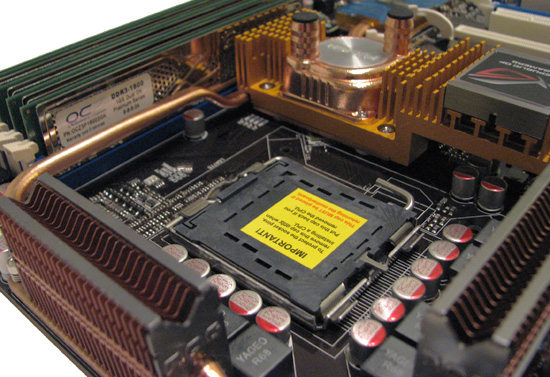
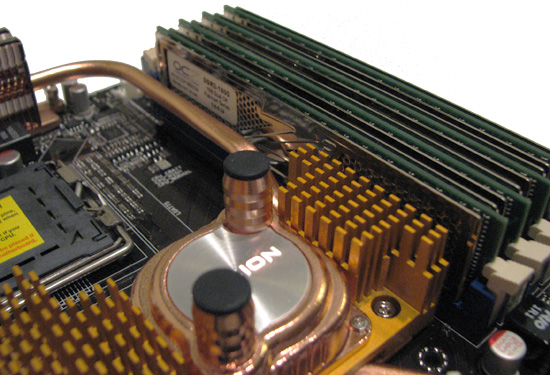
As with most good DDR3-based designs, the DIMMs are moved slightly down the board bringing them as close to the SPP as physically possible. This can sometimes make things quite cramped when trying to install a longer card in the top PCIe x1 slot. For example, we could not fit our ASUS Xonar D2X sound card in this slot without it contacting the bottom retention key on the closest DIMM slot.
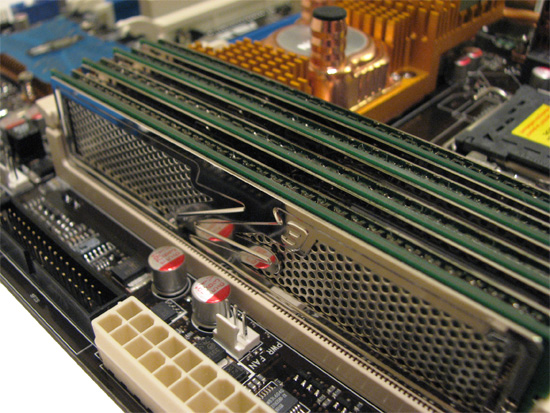
We found configuring our OCZ Platinum DDR3 PC3-14400 memory to run at their full-rated DDR3-1800 speed to be exceptionally simple. What's more, our ASUS Striker II Extreme had no trouble clocking even 8GB of top-end OCZ memory to DDR3-2000 speeds and above - something worth writing home about as far as we are concerned.
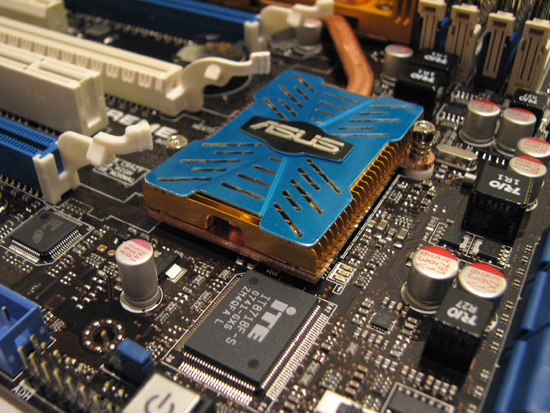
ASUS' MCP cooler is actually quite large - and for good reason, too. The NVIDIA 570i MCP can get very toasty doing a whole lot of nothing. Since it is attached to all the other major heat loads, it is entirely possible we were just seeing the effects of heat transfer from the hotter portions of the heatsink.
If you look closely, you can see the three LEDs located near the bottom-right corner of the cooler. The CPU, SPP, MCP, and memory each have a set of indicator lights - one green, one yellow, and one red - called "Voltminder LEDs". They give the user a quick way of determining roughly how hard each component is pushed. Green signifies that the component is seeing relatively low voltages, yellow warns of increasing stress while red is viewed as a stern warning that damage could occur without the proper precautions (i.e. increased cooling).
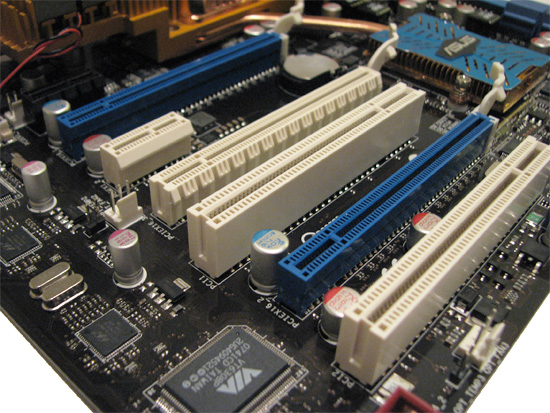
The Striker II Extreme has support for both 3-way SLI and Quad-SLI configurations, in addition to the more traditional 2-way SLI setup. The two blue PCIe x16 slots are PCI Express 2.0 compliant and should be used before a third graphics card is installed in the third white PCIe x16 slot (which is PCI Express 1.x compatible only). You can read more about performance tuning for graphic cards in our included 790i BIOS tuning guide.
The first PCIe x1 slot (black in color) can be used for either the included SupremeFX II 8-channel HD audio card or any other PCIe x1 device. A second PCIe x1 slot sits directly below the primary graphics slot. A pair of PCI 2.2 slots round out the board's expansion capabilities. Those that rely on wireless networks for connecting to the internet and/or other LAN resources will need to buy a separate wireless adapter as the Striker II Extreme only includes two hardwired RJ45 ports for Ethernet connectivity.










23 Comments
View All Comments
Rodriguez - Friday, June 20, 2008 - link
Can anyone here indicate how to reach FSB 500 (2000) with Striker II Extreme & QX9770 C1, most I can get is 1900FSB.I've seen Kris reach this speed in this article & was eager to get to this speed as soon as I received my new CPU, but it has been more difficult than I thought, I was sure that if with my previous Q6600 G0 y could easily get 1900/1950FSB, now with QX9770 would be peanuts. The main reason I bought this CPU was to run 2000FSB linked & synced with Ballistix 2000 SLI.
Please give all detailed BIOS setup options for this CPU if possible
Nobody in Asus forum using this setup has been able to reach 2000FSB, but I have seen a few reviews (like Anandtech's) & posts showing it's possible
By the way, memory has been tested unlinked at 2000Mhz 9-8-8-24, 1.9v P1/P2 Enabled & works great
System:
QX9770 rev. C1 3.2Ghz (watercooled)
Asus Striker II Extreme BIOS 801, ver 1.02G (watercooled)
PC Power & Cooling Turbo Cool 1200W
4 x 1GB Crucial Ballistix PC16000 SLI EPP2 , 2000Mhz 1800 8-7-7-24- 1T - 1.9v
SLI Leadtek PX8800 Ultra Leviathan (factory watercooled)
SLI Leadtek PX8800 Ultra
Asus Physx card (removed)
Dlink DWA556 PCIx Xtreme N Wireless card
2x WD Raptor 150GB Raid 0 300GB
1x Seagate 400GB Sata
X-Fi Platinum Fatal1ty Champion
24' Benq FP241VW Gamer
Innovatek XXD Rev 2 + G-Flow water cooling
CoolerMaster Cosmos 1000 case
Saitek X52 Flight system
TrackIR 4 + Trackclip Pro
Windows Vista Home Premium 32bit
parkerdw - Tuesday, June 3, 2008 - link
I used the same motherboard and cpu, but I liquid cooled it using the gigantic Kandalf Liquid Cooled case. My memory is different as well since I use 4 GB of Patriot Viper memory (2 x 2GB). Other than the memory settings in the BIOS, I set everything to match this guide. My system runs at 4.0Ghz and the cpu runs at no more than 88 degrees fahrenheit even while playing something like Crysis with everything set to Very High. Crysis runs between 35 and 60 fps on Very High on my system using a single 9800 GX2 at 1280 x 720. It's a HTPC connected to my older 56 inch DLP set via DVI, so I can't go any higher than that, but I fully expect to run great at 1080p when I get my new large screen set later this year. I don't have my bios settings in front of me, but setting everything to Auto for the memory works PERECTLY at 4.0 ghz. Pretty cool. I think it's running at 8,8,18 or so and 1.9v.Also, Asus just released a patch to the bios that fixes the data corruption issue mentioned in this artcle. Released on 5/29/08 I think.
hardist - Monday, April 21, 2008 - link
The water block seems to have leaking issues , I am wondering why it was not covered in this review since it is a major feature of this board ......Heatlesssun - Sunday, April 20, 2008 - link
This is a sweet motherbaord! Now I've not overclocked the FSB, just bumped up the multiplier of my QX9650 from the default of 9.5 to 10, and I'm not running RAID. We shall see but I feel good. To get this up and running with Vista x64 in a day so smoothly was pretty good I thought.electricx - Tuesday, April 15, 2008 - link
So this board is going for the aforementioned amount on newegg... The EVGA and the XFX 790i boards are going for $350... The ROG name carries that much of a premium? I mean, come on?! I'm sure ASUS will fix this data corruption issue and you typically do pay more for the privilege(?) of being a beta tester for high end hardware but $1000 over competing products seems a bit much... The EVGA board is looking to be a clear winner here to me. Time will tell I suppose.FightingEagle - Friday, April 18, 2008 - link
After the second EVGA 790i and full of bugs I just sent it back. I was interested in the ASUS X48 and the 790i, but the 790i over $400 is hard to grasp. EVGA has good looking heat sink but not very good at cooling. I may wait for all the bugs to leave but as now im sitting on $320 dollars worth of DDR3 and a E8400.electricx - Tuesday, April 15, 2008 - link
Edit: That should have been $100 not $1000UK1Man - Sunday, April 13, 2008 - link
Help please!!I'm currently in the process of building a computer but can only afford to buy a couple of parts a month, I have already purchased some DDR2 (1066) memory for an FXF 780 motherboard (not yet purchased) but am now considering the Asus striker II extreme.
Will my DDR 2 memory work with this?
seamusmc - Monday, April 14, 2008 - link
This board/chipset, 790i, only supports DDR3.ianken - Saturday, April 12, 2008 - link
Can it go into S3 suspend and come back out and have the NICs still work? The Striker 2 Formula cannot.Can the SATA controller handle hot swap? The Stiker 2 Formula and the previous 680i boards could not. The 680i bios even had an esata setting that did NOTHING.
The latest crop of Asus boards, particularly the NV chipset rigs, have been pretty buggy and basic functionality has been borked.
But hey, who cares of the basics don't work right? it's got a water block for X-TREME OVERCLOXORS! YO! VTEC!